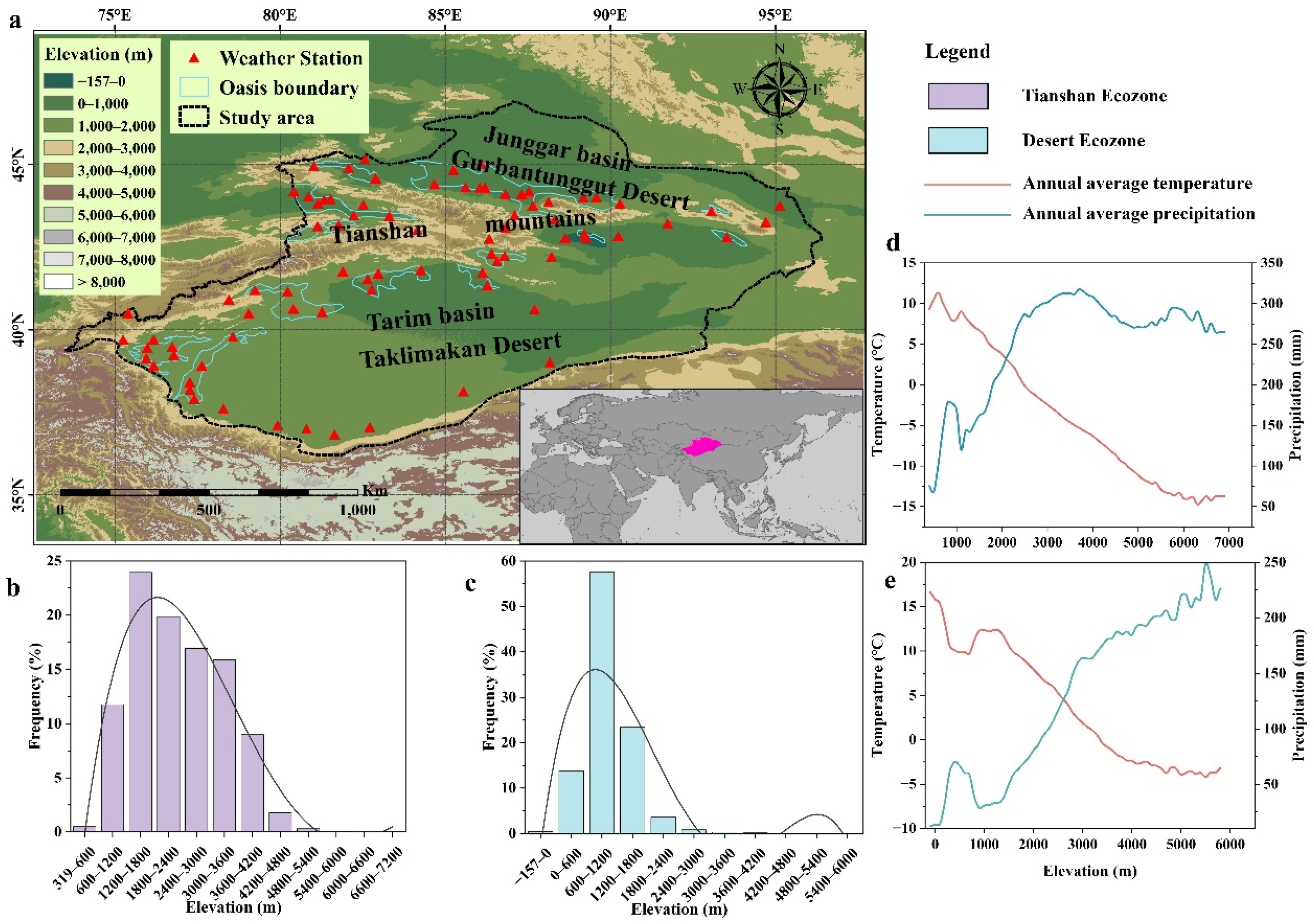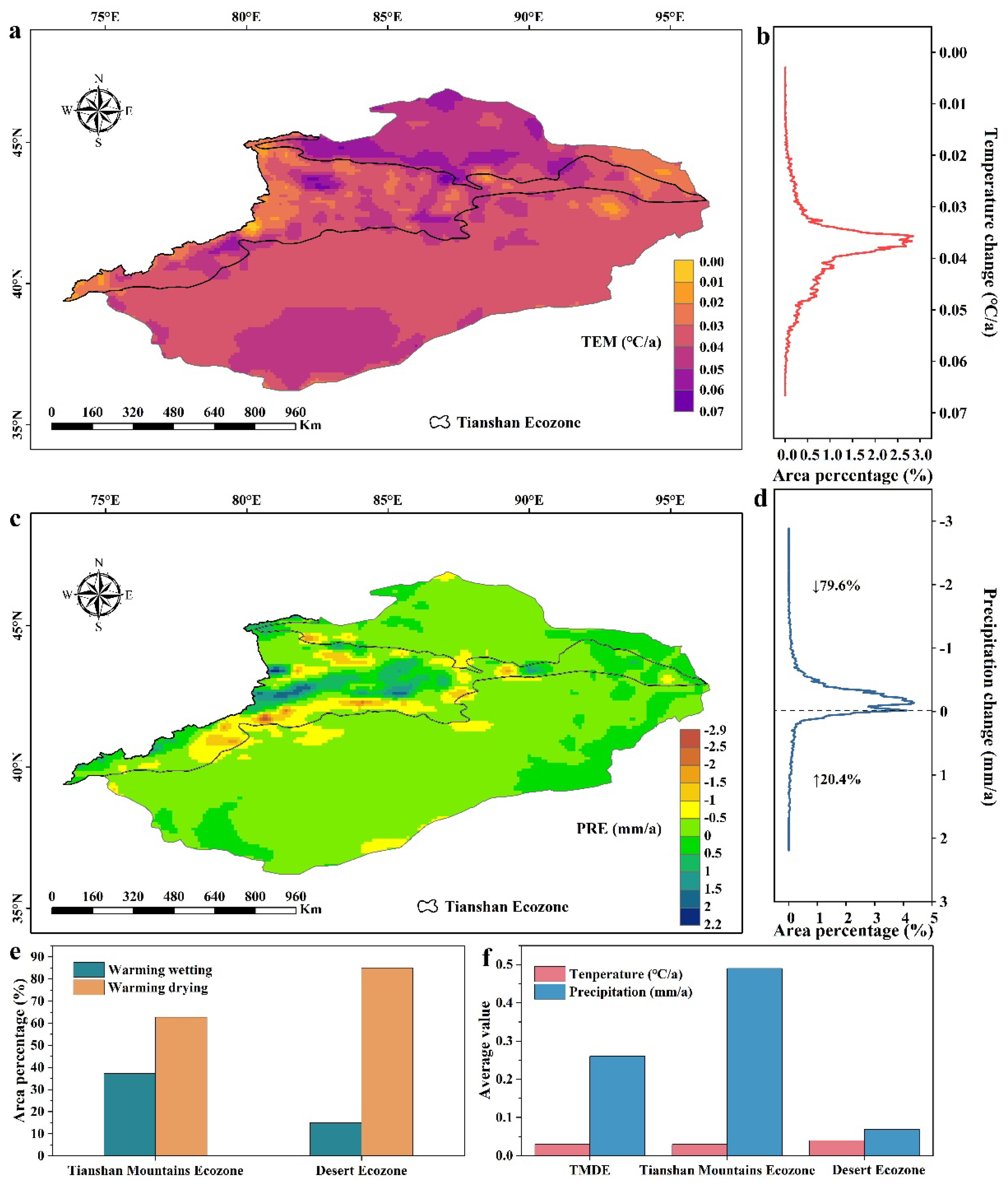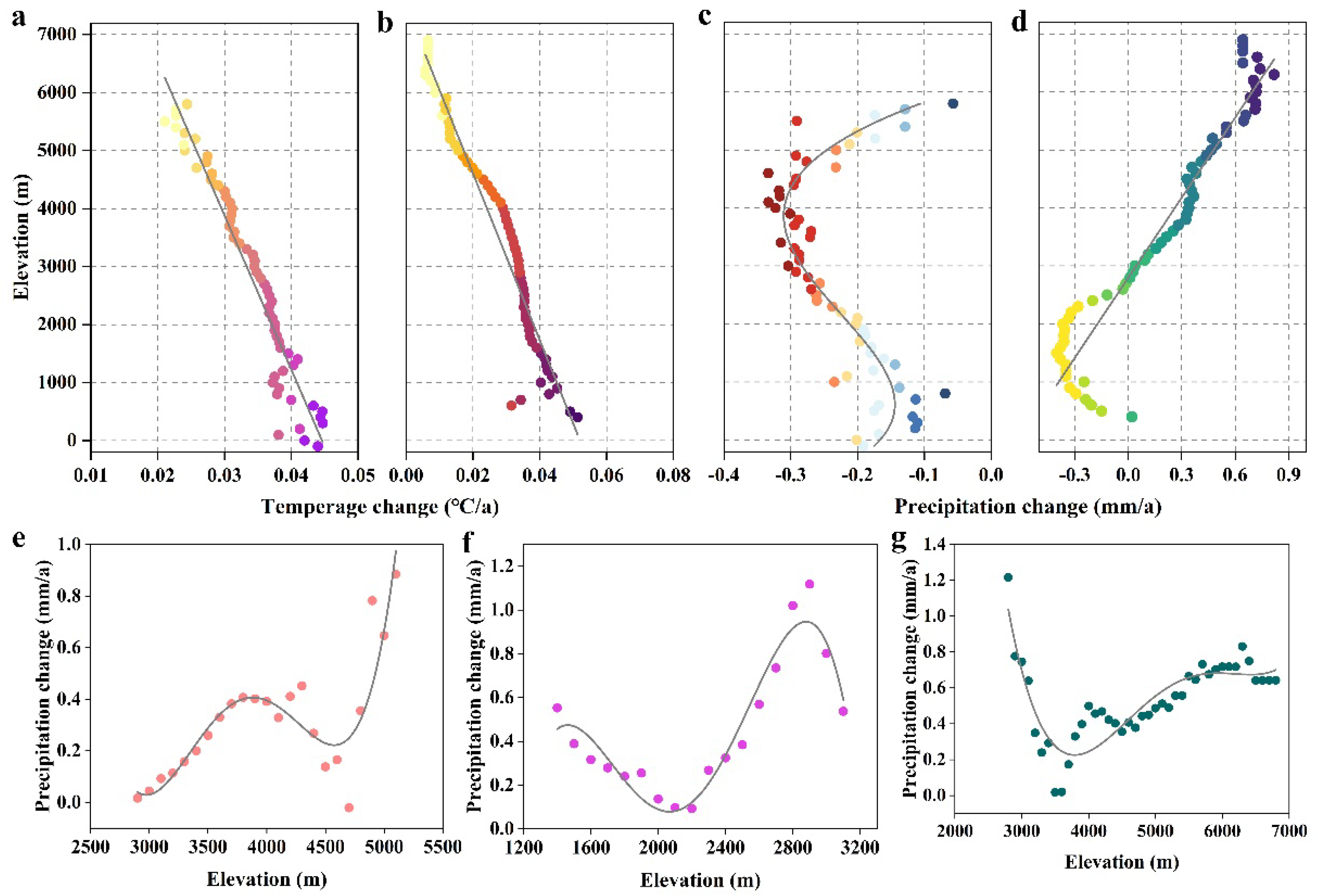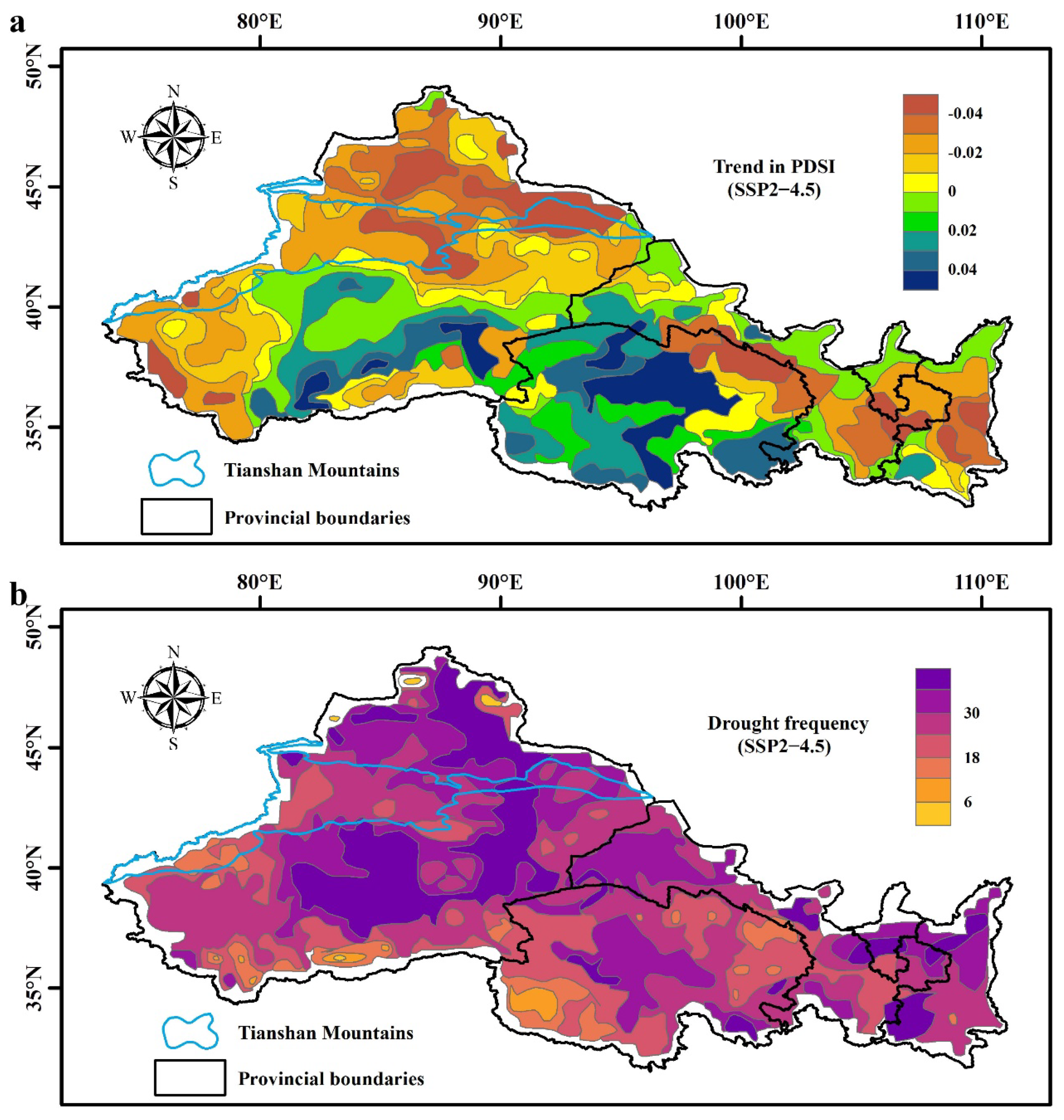High Mountains Becoming Wetter While Deserts Getting Drier in Xinjiang, China since the 1980s
Abstract
:1. Introduction
2. Study Area and Data
2.1. Study Area
2.2. Meteorological Data
2.3. Digital Elevation and Landcover Data
3. Results
3.1. Spatial Differences in Climate Trends
3.2. Altitudinal Difference in Climate Trends
3.3. Relationship between Warming and Wetting at High Altitudes
4. Discussion
4.1. Temporal and Spatial Differences in the Warming and Wetting Trends
4.2. Pronounced Warming and Drying Trends in Oases
4.3. Persistence of the Warming and Wetting Trend and Socioeconomic Implications
5. Conclusions
Author Contributions
Funding
Data Availability Statement
Acknowledgments
Conflicts of Interest
References
- Yao, J.Y.; Liu, H.P.; Huang, J.P.; Gao, Z.M.; Wang, G.Y.; Li, D.; Yu, H.P.; Chen, X.Y. Accelerated dryland expansion regulates future variability in dryland gross primary production. Nat. Commun. 2020, 11, 1665. [Google Scholar] [CrossRef] [Green Version]
- Zhang, A.Z.; Jia, G.S.; Epstein, H.E.; Xia, J.J. ENSO elicits opposing responses of semi-arid vegetation between Hemispheres. Sci Rep. UK 2017, 7, 42281. [Google Scholar] [CrossRef] [Green Version]
- Huang, J.; Li, Y.; Fu, C.; Chen, F.; Fu, Q.; Dai, A.; Shinoda, M.; Ma, Z.; Guo, W.; Li, Z.; et al. Dryland climate change: Recent progress and challenges. Rev. Geophys. 2017, 55, 719–778. [Google Scholar] [CrossRef]
- Huang, J.P.; Ji, M.X.; Xie, Y.K.; Wang, S.S.; He, Y.L.; Ran, J.J. Global semi-arid climate change over last 60 years. Clim. Dynam. 2016, 46, 1131–1150. [Google Scholar] [CrossRef] [Green Version]
- Huang, J.P.; Yu, H.P.; Guan, X.D.; Wang, G.Y.; Guo, R.X. Accelerated dryland expansion under climate change. Nat. Clim. Chang. 2016, 6, 166–171. [Google Scholar] [CrossRef]
- Pan, N.; Wang, S.; Liu, Y.X.; Li, Y.; Xue, F.; Wei, F.L.; Yu, H.P.; Fu, B.J. Rapid increase of potential evapotranspiration weakens the effect of precipitation on aridity in global drylands. J. Arid Environ. 2021, 186, 104414. [Google Scholar] [CrossRef]
- Loh, P.S.; Alnoor, H.I.M.; He, S.Y. Impact of Climate Change on Vegetation Cover at South Port Sudan Area. Climate 2020, 8, 114. [Google Scholar] [CrossRef]
- Daramola, M.T.; Xu, M. Recent changes in global dryland temperature and precipitation. Int. J. Climatol. 2021. [Google Scholar] [CrossRef]
- Strydom, S.; Savage, M.J.; Clulow, A.D. Long-term trends and variability in the dryland microclimate of the Northern Cape Province, South Africa. Theor. Appl. Climatol. 2019, 137, 963–975. [Google Scholar] [CrossRef]
- Zhao, Y.; Zhang, H.Q. Impacts of SST Warming in tropical Indian Ocean on CMIP5 model-projected summer rainfall changes over Central Asia. Clim. Dynam. 2016, 46, 3223–3238. [Google Scholar] [CrossRef] [Green Version]
- Deng, H.J.; Chen, Y.N.; Shi, X.; Li, W.H.; Wang, H.J.; Zhang, S.H.; Fang, G.H. Dynamics of temperature and precipitation extremes and their spatial variation in the arid region of northwest China. Atmos Res. 2014, 138, 346–355. [Google Scholar] [CrossRef]
- Junqiang, Y.; Yaning, C.; Jing, C.; Yong, Z.; Dilinuer, T.; Jiangang, L.; Lianmei, Y.; Weiyi, M. Intensification of extreme precipitation in arid Central Asia. J. Hydrol. 2020, 598, 125760. [Google Scholar] [CrossRef]
- Li, B.F.; Chen, Y.N.; Chen, Z.S.; Xiong, H.G.; Lian, L.S. Why does precipitation in northwest China show a significant increasing trend from 1960 to 2010? Atmos Res. 2016, 167, 275–284. [Google Scholar] [CrossRef]
- Wang, Q.; Zhai, P.M.; Qin, D.H. New perspectives on ‘warming-wetting’ trend in Xinjiang, China. Adv. Clim. Chang. Res. 2020, 11, 252–260. [Google Scholar] [CrossRef]
- Yu, Y.; Pi, Y.Y.; Yu, X.; Ta, Z.J.; Sun, L.X.; Disse, M.; Zeng, F.J.; Li, Y.M.; Chen, X.; Yu, R.D. Climate change, water resources and sustainable development in the arid and semi-arid lands of Central Asia in the past 30 years. J. Arid Land 2019, 11, 1–14. [Google Scholar] [CrossRef] [Green Version]
- Kirpotin, S.N.; Callaghan, T.V.; Peregon, A.M.; Babenko, A.S.; Berman, D.I.; Bulakhova, N.A.; Byzaakay, A.A.; Chernykh, T.M.; Chursin, V.; Interesova, E.A.; et al. Impacts of environmental change on biodiversity and vegetation dynamics in Siberia. Ambio 2021, 1–27. [Google Scholar] [CrossRef]
- Li, X.P.; Wang, L.; Guo, X.Y.; Chen, D.L. Does summer precipitation trend over and around the Tibetan Plateau depend on elevation? Int. J. Climatol. 2017, 37, 1278–1284. [Google Scholar] [CrossRef]
- Crowhurst, D.; Dadson, S.; Peng, J.; Washington, R. Contrasting controls on Congo Basin evaporation at the two rainfall peaks. Clim. Dynam. 2021, 56, 1609–1624. [Google Scholar] [CrossRef]
- Guan, Y.L.; Lu, H.W.; Yin, C.; Xue, Y.X.; Jiang, Y.L.; Kang, Y.; He, L.; Heiskanen, J. Vegetation response to climate zone dynamics and its impacts on surface soil water content and albedo in China. Sci. Total Environ. 2020, 747, 141537. [Google Scholar] [CrossRef]
- Usman, M.; Nichol, J.E.; Ibrahim, A.T.; Buba, L.F. A spatio-temporal analysis of trends in rainfall from long term satellite rainfall products in the Sudano Sahelian zone of Nigeria. Agric. Forest Meteorol. 2018, 260, 273–286. [Google Scholar] [CrossRef]
- Chen, C.F.; Yang, S.; Li, Y.Y. Accuracy Assessment and Correction of SRTM DEM Using ICESat/GLAS Data under Data Coregistration. Remote Sens. 2020, 12, 3435. [Google Scholar] [CrossRef]
- Wan, H.; Wang, X.; Luo, L.; Guo, P.; Zhao, Y.; Wu, K.; Ren, H. Remotely-Sensed Identification of a Transition for the Two Ecosystem States Along the Elevation Gradient: A Case Study of Xinjiang Tianshan Bogda World Heritage Site. Remote Sens. 2019, 11, 2861. [Google Scholar] [CrossRef] [Green Version]
- Zhang, H.X.; Zhang, M.L.; Sanderson, S.C. Retreating or Standing: Responses of Forest Species and Steppe Species to Climate Change in Arid Eastern Central Asia. PLoS ONE 2013, 8, e61954. [Google Scholar] [CrossRef] [Green Version]
- Yang, H.; Xu, G.Y.; Mao, H.X.; Wang, Y. Spatiotemporal Variation in Precipitation and Water Vapor Transport Over Central Asia in Winter and Summer Under Global Warming. Front. Earth Sc. Switz. 2020, 8, 297. [Google Scholar] [CrossRef]
- Chen, F.H.; Huang, W.; Jin, L.Y.; Chen, J.H.; Wang, J.S. Spatiotemporal precipitation variations in the arid Central Asia in the context of global warming. Sci. China Earth Sci. 2011, 54, 1812–1821. [Google Scholar] [CrossRef]
- Luo, M.; Liu, T.; Meng, F.H.; Duan, Y.C.; Bao, A.M.; Frankl, A.; De Maeyer, P. Spatiotemporal characteristics of future changes in precipitation and temperature in Central Asia. Int. J. Climatol. 2019, 39, 1571–1588. [Google Scholar] [CrossRef]
- Fu, A.H.; Chen, Y.N.; Li, W.H.; Li, B.F.; Yang, Y.H.; Zhang, S.H. Spatial and temporal patterns of climate variations in the Kaidu River Basin of Xinjiang, Northwest China. Quatern. Int. 2013, 311, 117–122. [Google Scholar] [CrossRef]
- Li, B.F.; Chen, Y.N.; Shi, X.; Chen, Z.S.; Li, W.H. Temperature and precipitation changes in different environments in the arid region of northwest China. Theor. Appl. Climatol. 2013, 112, 589–596. [Google Scholar] [CrossRef]
- Cai, P.; Hamdi, R.; He, H.L.; Luo, G.P.; Wang, J.; Zhang, M.; Li, C.F.; Termonia, P.; De Maeyer, P. Numerical Study of the Interaction between Oasis and Urban Areas within an Arid Mountains-Desert System in Xinjiang, China. Atmosphere 2020, 11, 85. [Google Scholar] [CrossRef] [Green Version]
- Amuti, T.; Luo, G. Analysis of land cover change and its driving forces in a desert oasis landscape of Xinjiang, northwest China. Solid Earth 2014, 5, 1071–1085. [Google Scholar] [CrossRef] [Green Version]
- Huang, J.P.; Ma, J.R.; Guan, X.D.; Li, Y.; He, Y.L. Progress in Semi-arid Climate Change Studies in China. Adv. Atmos Sci. 2019, 36, 922–937. [Google Scholar] [CrossRef]
- Cai, P.; Hamdi, R.; Luo, G.P.; He, H.L.; Zhang, M.; Termonia, P.; De Maeyer, P. Agriculture intensification increases summer precipitation in Tianshan Mountains, China. Atmos Res. 2019, 227, 140–146. [Google Scholar] [CrossRef]
- Zhang, M.; Luo, G.P.; Cao, X.S.; Hamdi, R.; Li, T.; Cai, P.; Ye, H.; He, H.L. Numerical Simulation of the Irrigation Effects on Surface Fluxes and Local Climate in Typical Mountain-Oasis-Desert Systems in the Central Asia Arid Area. J. Geophys. Res. Atmos. 2019, 124, 12485–12506. [Google Scholar] [CrossRef]
- Liu, R.; Sogachev, A.; Yang, X.F.; Liu, S.M.; Xu, T.R.; Zhang, J.J. Investigating microclimate effects in an oasis-desert interaction zone. Agric. Forest Meteorol. 2020, 290, 107992. [Google Scholar] [CrossRef]
- Hao, X.M.; Li, W.H.; Deng, H.J. The oasis effect and summer temperature rise in arid regions—Case study in Tarim Basin. Sci. Rep. 2016, 6, 35418. [Google Scholar] [CrossRef]
- Fan, C.; Myint, S.W.; Kaplan, S.; Middel, A.; Zheng, B.; Rahman, A.; Huang, H.-P.; Brazel, A.; Blumberg, D.G. Understanding the Impact of Urbanization on Surface Urban Heat Islands—A Longitudinal Analysis of the Oasis Effect in Subtropical Desert Cities. Remote Sens. 2017, 9, 672. [Google Scholar] [CrossRef] [Green Version]
- Huang, A.N.; Zhou, Y.; Zhang, Y.C.; Huang, D.Q.; Zhao, Y.; Wu, H.M. Changes of the Annual Precipitation over Central Asia in the Twenty-First Century Projected by Multimodels of CMIP5. J. Clim. 2014, 27, 6627–6646. [Google Scholar] [CrossRef]
- Xue, L.Q.; Zhu, B.L.; Yang, C.B.; Wei, G.H.; Meng, X.Y.; Long, A.H.; Yang, G. Study on the characteristics of future precipitation in response to external changes over arid and humid basins. Sci. Rep. 2017, 7, 15148. [Google Scholar] [CrossRef] [Green Version]
- Yang, J.; Fang, G.H.; Chen, Y.N.; De-Maeyer, P. Climate change in the Tianshan and northern Kunlun Mountains based on GCM simulation ensemble with Bayesian model averaging. J. Arid Land 2017, 9, 622–634. [Google Scholar] [CrossRef]
- Wang, Y.J.; Zhou, B.T.; Qin, D.H.; Wu, J.; Gao, R.; Song, L.C. Changes in Mean and Extreme Temperature and Precipitation over the Arid Region of Northwestern China: Observation and Projection. Adv. Atmos. Sci. 2017, 34, 289–305. [Google Scholar] [CrossRef]
- Yin, Z.L.; Feng, Q.; Yang, L.S.; Deo, R.C.; Adamowski, J.F.; Wen, X.H.; Jia, B.; Si, J.H. Projected spatial patterns in precipitation and air temperature for China’s northwest region derived from high-resolution regional climate models. Int. J. Climatol. 2020, 40, 3922–3941. [Google Scholar] [CrossRef]
- Jiang, J.; Zhou, T.J.; Chen, X.L.; Zhang, L.X. Future changes in precipitation over Central Asia based on CMIP6 projections. Environ. Res. Lett. 2020, 15, 054009. [Google Scholar] [CrossRef]
- Zhai, J.Q.; Mondal, S.K.; Fischer, T.; Wang, Y.J.; Su, B.D.; Huang, J.L.; Tao, H.; Wang, G.J.; Ullah, W.; Uddin, M.J. Future drought characteristics through a multi-model ensemble from CMIP6 over South Asia. Atmos. Res. 2020, 246, 105111. [Google Scholar] [CrossRef]
- Xu, K.; Wu, C.H.; Zhang, C.; Hu, B.X. Uncertainty assessment of drought characteristics projections in humid subtropical basins in China based on multiple CMIP5 models and different index definitions. J. Hydrol. 2021, 600, 126502. [Google Scholar] [CrossRef]
- Li, S.Y.; Miao, L.J.; Jiang, Z.H.; Wang, G.J.; Gnyawali, K.R.; Zhang, J.; Zhang, H.; Fang, K.; He, Y.; Li, C. Projected drought conditions in Northwest China with CMIP6 models under combined SSPs and RCPs for 2015-2099. Adv. Clim. Chang. Res. 2020, 11, 210–217. [Google Scholar] [CrossRef]
- Berg, A.; Findell, K.; Lintner, B.; Giannini, A.; Seneviratne, S.I.; van den Hurk, B.; Lorenz, R.; Pitman, A.; Hagemann, S.; Meier, A.; et al. Land-atmosphere feedbacks amplify aridity increase over land under global warming. Nat. Clim. Chang. 2016, 6, 869–874. [Google Scholar] [CrossRef]
- Lian, X.; Piao, S.; Chen, A.; Huntingford, C.; Fu, B.; Li, L.Z.X.; Huang, J.; Sheffield, J.; Berg, A.M.; Keenan, T.F.; et al. Multifaceted characteristics of dryland aridity changes in a warming world. Nat. Rev. Earth Environ. 2021, 2, 232–250. [Google Scholar] [CrossRef]






Publisher’s Note: MDPI stays neutral with regard to jurisdictional claims in published maps and institutional affiliations. |
© 2021 by the authors. Licensee MDPI, Basel, Switzerland. This article is an open access article distributed under the terms and conditions of the Creative Commons Attribution (CC BY) license (https://creativecommons.org/licenses/by/4.0/).
Share and Cite
Zhang, Y.; An, C.; Liu, L.; Zhang, Y.; Lu, C.; Zhang, W. High Mountains Becoming Wetter While Deserts Getting Drier in Xinjiang, China since the 1980s. Land 2021, 10, 1131. https://doi.org/10.3390/land10111131
Zhang Y, An C, Liu L, Zhang Y, Lu C, Zhang W. High Mountains Becoming Wetter While Deserts Getting Drier in Xinjiang, China since the 1980s. Land. 2021; 10(11):1131. https://doi.org/10.3390/land10111131
Chicago/Turabian StyleZhang, Yong, Chengbang An, Luyu Liu, Yanzhen Zhang, Chao Lu, and Wensheng Zhang. 2021. "High Mountains Becoming Wetter While Deserts Getting Drier in Xinjiang, China since the 1980s" Land 10, no. 11: 1131. https://doi.org/10.3390/land10111131
APA StyleZhang, Y., An, C., Liu, L., Zhang, Y., Lu, C., & Zhang, W. (2021). High Mountains Becoming Wetter While Deserts Getting Drier in Xinjiang, China since the 1980s. Land, 10(11), 1131. https://doi.org/10.3390/land10111131







